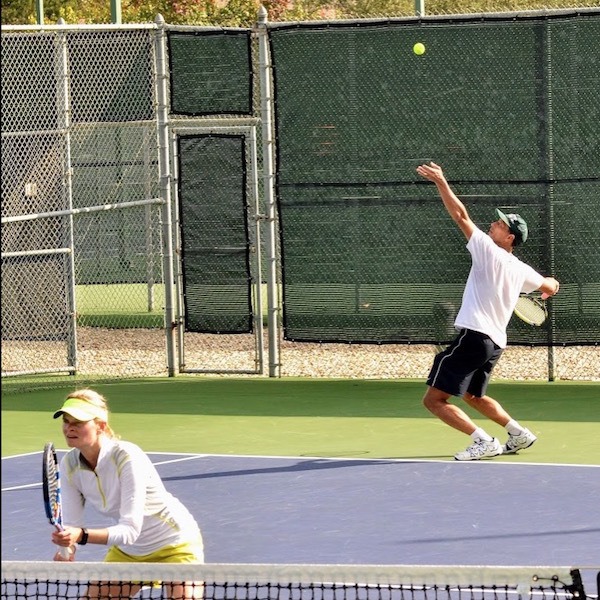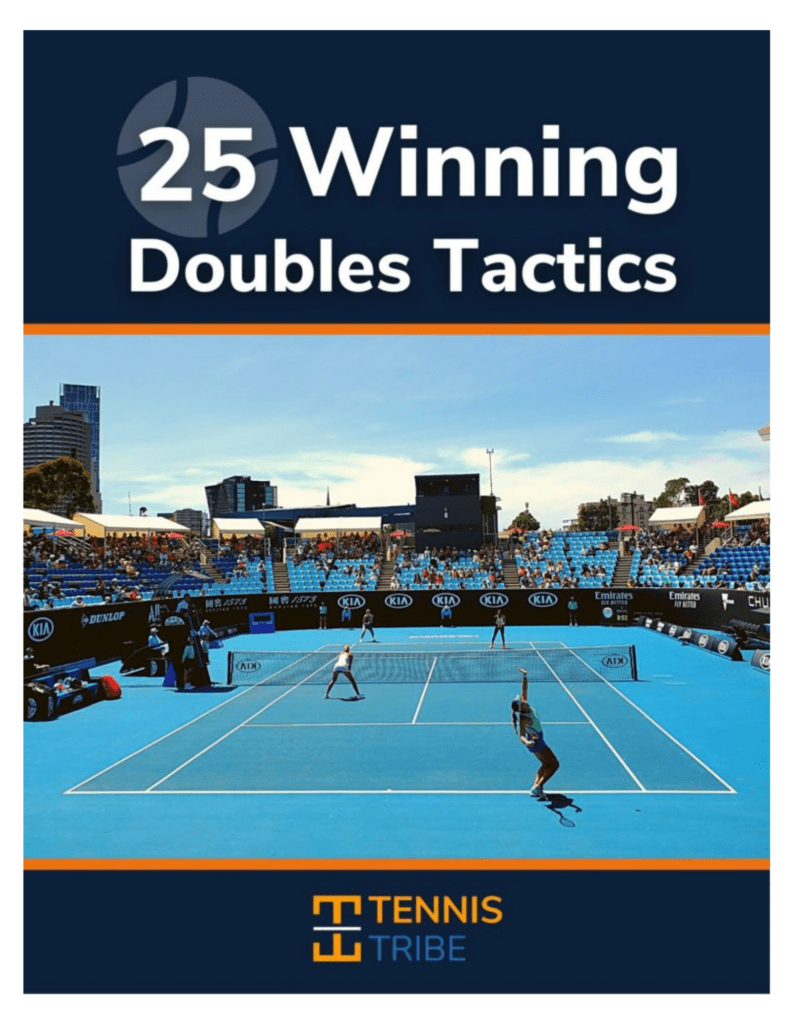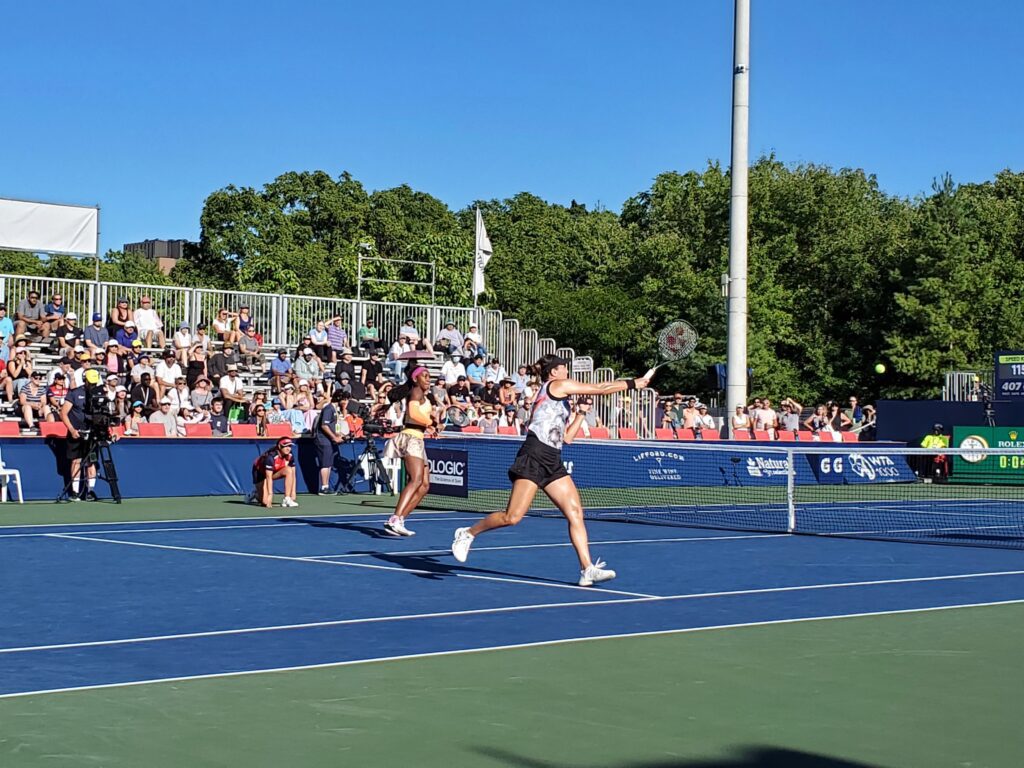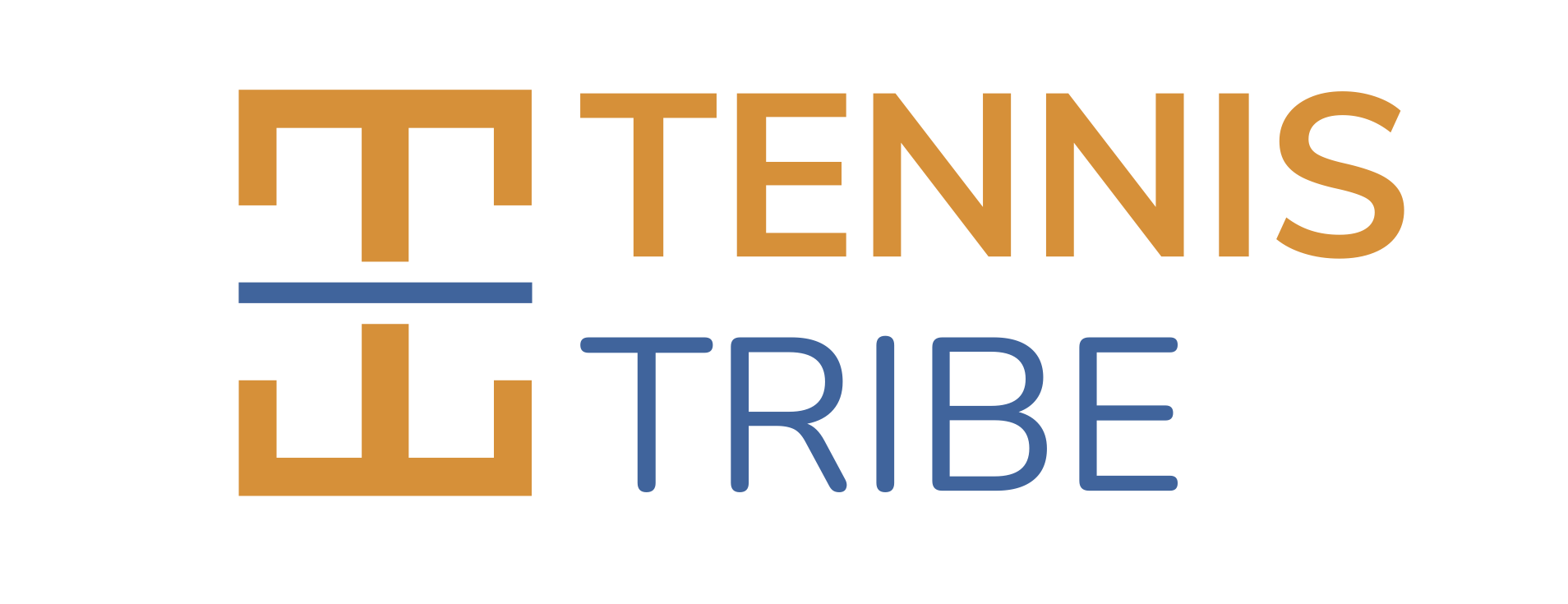In tennis, doubles is a partnership. The stronger your partnership is in terms of communication, trust, and doubles strategy, the better your chances of winning.
One question that came up recently from a reader was when, as the net player, you should take the middle ball and when should you let your partner take it. So that’s what you’re going to learn today.
Covering the Middle in the Deuce Court
Your partner is serving, and they hit a body serve to the opponent who strikes a return over the middle net strap, a great return strategy for doubles.
Your doubles partner then hits a backhand into the net.
In a lot of cases, players will blame the partner who missed the backhand for losing this point. But in reality, it’s not so clear.
It’s a bad idea to blame one person on a doubles team, but for the sake of this exercise, let’s say someone has a gun to my head and is making me blame one person.
Before they pull the trigger, I’d have a few followup questions.
- Was it a 1st or 2nd serve?
- Did you (the net player) know that a body serve was coming?
- Are you right-handed?
Let’s go through a few scenarios.
Scenario #1
Let’s say it was a 1st serve. You and your partner talk about serve strategy before each point and called the body serve.
I would, in this scenario, “blame” you, especially if you’re are right-handed.
Let’s examine why…
On the 1st serve, you should be more aggressive by pinching towards the middle, or poaching.

If you knew it was a body serve, then there is no reason to cover the alley because the returner doesn’t have a great angle to pass you.
Since you’re right-handed, your forehand is in the middle of the court. This means you’ll have a better volley and be able to reach more to cover the middle, so your partner doesn’t have to hit a backhand.
If your forehand volley is in the middle, priority #1 is to cover the middle and protect your partner’s backhand.
Scenario #2
Let’s say it was a 2nd serve, and your partner called a wide serve but missed their spot.
In this case, the “person to blame” isn’t so clear.
- It’s more difficult to be aggressive on the 2nd serve.
- A wide 2nd serve gives the returner an easy angle down the line (especially if it’s a forehand).
- Your partner missed their spot.
All that said, I’d still blame the net player. Unless you had been beaten down the line consistently by that returner already in the match, you should still be owning the middle of the court as much as you can.

25 Winning Doubles Tactics Guaranteed to Help You Play Smarter
Ebook with 25 expert serve (7), return (5), net-play (5), baseline (4), & approach (4) tactics you can use in your next doubles match.
Covering the Middle in the Ad Court
In the ad court, it becomes more difficult to decide, as the net player, if you should take the middle ball.
You now have a backhand volley, and your partner has a forehand groundstroke.

In doubles: volley > groundstroke.
However, in tennis: forehand > backhand.
So how do we weigh these options against each other?
From the deuce court, we can wait to move and be comfortable with most forehand volleys we get. However, in this scenario, we have to read the opponent more and see what type of ball they are hitting.
To help you decide how aggressive to be, we’ll use a few simple rules.
Rule 1: When the opponent looks uncomfortable, pinch or poach
If you see them hitting an off-balanced backhand, from deep in the court, we can be more aggressive. Poaching early is a good option because you can force an error and not have to touch the ball.
If they’re hitting a short forehand, we probably want to stay home and let our partner take the ball.
Pro Tip: If they’re hitting a short forehand, ask yourself how they got in that position. How can you avoid it next time?
Rule 2: Take the high balls, leave the low balls
You’ll want to read the ball as well.
If it’s a high ball over the net, go for it. But if the opponent hits a low ball with a lot of pace, it will be a more difficult backhand volley.
In general, a doubles team should figure out which person improves the odds of the team winning the point most by taking the ball in the middle. In my course, The Mental Game Masterclass, I discuss principles and frameworks for working through these decisions.
Do you have a scenario when you’re not sure what to do? Comment below and I’ll give you my best doubles tips & advice.

Hi Will as ever good food for thought supported by logic.
I favour a simple approach that takes away options, decision making, what ifs.
So for us…..two things.
1. A serve consists of two shots. The aim of the serve is to set up the second shot , normally, invariably, the partner at the net
2. ANY ball that crosses the net a metre or so either side of the net chord SHOULD be the partners ball regardless of whether its their backhand or forehand volley. The server from the deuce court should ONLY be looking for a forehand shot or volley and from the ad side should ONLY be looking for a backhand volley
SIMPLES
I have a personal HATE for the word POACH as it implies you have stolen your partner servers ball …and woe betide you if you muck up.
Instead it should always be your ball by default. If you do NOT hunt for it then the server has cause to complain
best Mark
I love the simplicity Mark! Thanks for the contribution 🙂
Both players at net. Forehands in middle (leftie deuce, righties add side) who’s responsible for middle ball?
Great question Nancy! the answer is… it depends.
It’s usually best to use a staggered formation at the net. If the opponent is hitting the ball from the deuce court, then your ad court player should be shifted forward close to the net. Your deuce court player should be slightly back to cover a lob. In that case, the ad court player will have first access to the forehand volley and can take it if they want.
>> More on shifting in doubles in the Gigi Fernandez podcast episode: https://www.thetennistribe.com/gigi-fernandez-interview/
In a lot of cases though, the perfect shot can go through the middle and both players should go for it 😉
Both players at the back by the service line and the opponent returns the ball to the middle the back hand players call for the ball and the forehand players also called for the ball. Who should hit the ball back
Hi Kayode, great question.
In this case, usually the player with the forehand should take the ball. However, if the backhand player has a better backhand than the forehand of their partner, they can take it. There’s no “right answer” here. You have to work with your doubles partner to decide what is best for your team.